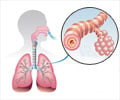Research has shown that rescue workers of New York City's fire department involved in 9/11 rescue efforts have been found to have reduced lung functions equivalent to 12 years of respiratory decline in a person due to aging in the year after the 9/11 attacks.
Lungs tests of the rescue workers showed that those present in the very early stages of the twin tower collapse suffered most damage. Since routine tests are carried out every 18 months as a part of routine medical screening on the New York City Fire Department workers, Dr. Gisela Banauch and colleagues at Montefiore Medical Center in New York were able to look at the respiratory function of the workers before and after the disaster.Tests carried out in 12,079 rescue workers in the 12 months after the disaster were compared with the earlier tests before the disaster and this revealed a substantial reduction in forced expiratory volume in the year after 9/11.
Banauch and her team found the lung-capacity declines were steepest in those who were either present when the twin towers collapsed or arrived later that morning. The findings showed that those exposed in the fist couple of days after the collapse of the twin towers had more severe respiratory symptoms than those who arrived later.
The study published in the American Journal of Respiratory and Critical Care Medicine also notes that only 22% of workers who arrived early reported wearing a mask on the first day, but this had gradually risen to about 50% by the third day. "The lesson is that adequate respiratory protection should be available promptly for first responders, which sounds great but is obviously difficult to implement," Banauch said.
The massive exposure to pulverized building materials and combustion products and dust has led to many of the workers suffering from irritant-induced asthma and reactive airways dysfunction syndrome (RADS) and in a significant number of these workers it has even affected their ability to work.
Dr Banauch said it was impossible to predict whether the dust-exposed workers will continue to experience an accelerated decline in lung function, but added that the massive exposure to irritating alkaline dust could possibly increase some workers' future risk of developing emphysema and lung cancer.
Advertisement
Dr Paul Cullinan, an occupational and environmental respiratory disease specialist at Imperial College, commended the researchers on their study. He said the he was surprised at the extent of the respiratory problems identified by the researchers.
Advertisement







